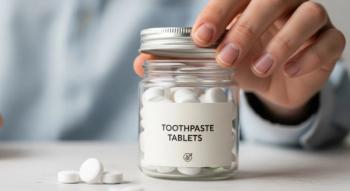
- July 2022
- Volume 88
- Issue 7
Maintain Bone Health to Prevent Osteoporosis
Pharmacists can recommend calcium, smoking cessation products, and vitamin D to stave off this common condition.
Osteoporosis is a bone disease that involves decreased bone mass, low bone density, and structural bone changes that can lead to an increased risk of fractures. Approximately 54 million individuals in the United States have low bone density or osteoporosis, according to the Bone Health and Osteoporosis Foundation (BHOF).1
Women are 4 times more likely to develop osteoporosis than men,2 and women 50 years and older are especially at increased risk of osteoporosis.3 Family education about bone health, especially during childhood, is critical because peak bone mass is acquired by aged 18 years.4
Because there are generally no symptoms with osteopenia, or low bone mass, and osteoporosis, they often go undetected until a fracture occurs. Regular muscle-strengthening and weight-bearing physical activities are critical for fracture prevention. The World Health Organization defines osteopenia as a bone mineral density T-score between –1 and –2.5 and osteoporosis as a T-score at or below –2.5.3
Pharmacists play a key role here through counseling on appropriate OTC products to prevent osteoporosis, which include calcium and vitamin D supplements.
Products and Counseling Pearls
Calcium
Calcium and vitamin D products are important medications that can help prevent osteoporosis, and they are found in multivitamins and other dietary supplements. Additionally, there are supplements that contain calcium only and calcium plus vitamin D.
Women aged 19 to 50 years should receive 1000 mg of calcium per day, and women 51 years and older should have 1200 mg of calcium per day.3,5 These total daily amounts include both dietary and supplemental calcium. Pharmacists should educate patients not to exceed 1200 to 1500 mg per day from calcium supplements because that can increase the risk of developing kidney stones.3,6
Good dietary sources of calcium include almond or soy milk, cheese, fortified foods or juices, and regular milk.3,7 If adequate dietary calcium is not achieved, then OTC supplements should be recommended.
Calcium supplements typically contain calcium carbonate (Caltrate) or calcium citrate (Citracal). These contain different amounts of elemental calcium, which is the actual amount of calcium in the supplement. For instance, calcium carbonate contains 40% elemental calcium, and calcium citrate contains 21%.3
Be sure to advise patients to avoid taking more than 500 mg of a calcium supplement at a time because the body is usually unable to absorb higher doses.3 Patients should also consult OTC drug facts labels, which provide information about the amount of elemental calcium in each product. Because calcium carbonate requires stomach acid for absorption, it is important to take these supplements with food.3 Calcium citrate products can be taken with or without food, because stomach acid is not required for absorption.3
Patients receiving proton pump inhibitor therapy, which reduces gastric acid, and those with the following conditions benefit from calcium citrate supplements: absorption disorders, achlorhydria (the absence of hydrochloric acid in stomach), and inflammatory bowel disease.3
Evidence is mixed whether calcium supplements with or without vitamin D are associated with an increased risk of cardiovascular disease.3 One meta-analysis and systemic review found that supplements containing calcium alone or calcium plus vitamin D did not increase cardiovascular disease risk.8
Vitamin D
Vitamin D helps the body absorb calcium, which is needed for mineralization of bone.7 The BHOF recommends 800 to 1000 units per day of vitamin D for adults 50 years and older.3 Individuals younger than 50 years should receive 400 to 800 units per day.7 Patients with vitamin D deficiency generally require higher doses.
Because individuals typically do not obtain an adequate amount of vitamin D from sunlight or their diet, supplementation is usually needed. Supplements typically contain either vitamin D2 (ergocalciferol) or vitamin D3 (cholecalciferol), which are both considered effective options.3 However, vitamin D3 products are preferred because they are produced in humans and are more highly absorbed.3 Vitamin D2 is derived from plant sources and can be recommended for patients on a strict vegan or vegetarian diet.3
The BHOF recommends that patients have a serum 25-hydroxyvitamin D concentration of approximately 30 ng/mL because it is associated with optimal calcium absorption.3
Targeting a serum 25-hydroxyvitamin D level of 30 ng/mL to 50 ng/mL is optimal.3 Patients at risk of vitamin D deficiency include those with advanced osteoarthritis, chronic renal insufficiency, or limited sun exposure.3 Assessing vitamin D levels is critical to ensure that patients receive adequate supplementation.
Smoking Cessation
Smoking is a risk factor for osteoporosis and bone fracture, and evidence shows that tobacco use is associated with decreased bone mineral density.9 Pharmacists can play a significant role in recommending smoking cessation products for osteoporosis prevention. A variety of OTC nicotine replacement– therapy products are available: gum (Nicorette), lozenges (Nicorette) and the patch (NicoDerm CQ).10 Evidence shows that using 2 of these therapies together, such as a nicotine patch plus the gum or lozenge, can be more effective for smoking cessation than monotherapy.10
About The Author
Jennifer Gershman, PharmD, CPh, PACS, is a drug information pharmacist and Pharmacy Times® contributor who resides in South Florida.
References
1. May is osteoporosis awareness and prevention month. Bone Health and Osteoporosis Foundation. Accessed May 26, 2022. https://www.bonehealthandosteoporosis.org/awareness-month/#:~:text=Approximately%2054%20million%20Americans%20have,help%20achieve%20better%20bone%20health
2. What is osteoporosis and how does it impact older adults? National Council on Aging. March 4, 2022. Accessed May 28, 2022. https://ncoa.org/article/what-is-osteoporosis-and-how-does-it-impact-older-adults
3. LeBoff MS, Greenspan SL, Insogna KL, et al. The clinician’s guide to prevention and treatment of osteoporosis. Osteoporos Int. Published online April 28, 2022. doi:10.1007/s00198-021-05900-y
4. Kids and their bones: a guide for parents. National Institutes of Health. Accessed Updated October 2018. May 26, 2022. https://www.bones.nih.gov/health-info/bone/bone-health/juvenile
5. Calcium. National Institutes of Health. Accessed May 27, 2022. https://ods.od.nih.gov/factsheets/Calcium-HealthProfessional/
6. Calcium oxalate stones. National Kidney Foundation. Accessed May 27, 2022. https://www.kidney.org/atoz/content/calcium-oxalate-stone
7. Calcium and vitamin D. Bone Health andOsteoporosis Foundation. Updated June 2, 2022. Accessed June22, 2022. https://www.bonehealthandosteoporosis.org/patients/treatment/calciumvitamin-d/
8. Chung M, Tang AM, Fu Z, Wang DD, Newberry SJ. Calcium intake and cardiovascular disease risk: an updated systematic review and meta-analysis. Ann Intern Med. 2016;165(12):856-866. Doi:10.7326/M16-1165
9. Smoking and bone health. National Institutes of Health. Updated December 2018. Accessed May 30, 2022. https://www.bones.nih.gov/health-info/bone/osteoporosis/conditions-behaviors/bone-smoking
10. How to use quit smoking medicines. CDC. Updated May 24, 2021. Accessed May 30, 2022. https://www.cdc.gov/tobacco/campaign/tips/quit-smoking/quit-smoking-medications/how-to-use-quit-smoking-medicines/index.html
Articles in this issue
over 3 years ago
National Practitioner Data Bank Aims to Reduce Malpracticeover 3 years ago
Pet Peeves: July 2022over 3 years ago
July 2022: Generic Product Newsover 3 years ago
Pharmacists Can Help Manage Patients With Parkinson Diseaseover 3 years ago
Quviviq From Idorsia Pharmaceuticalsover 3 years ago
OTC Case Studies: Rhinitisover 3 years ago
July 2022: Rx Product Newsover 3 years ago
Know Your Salary Rangeover 3 years ago
Help Patients Use Inhalers Properlyover 3 years ago
Illinois Legislature Empowers PharmacistsNewsletter
Stay informed on drug updates, treatment guidelines, and pharmacy practice trends—subscribe to Pharmacy Times for weekly clinical insights.













































































































































































































